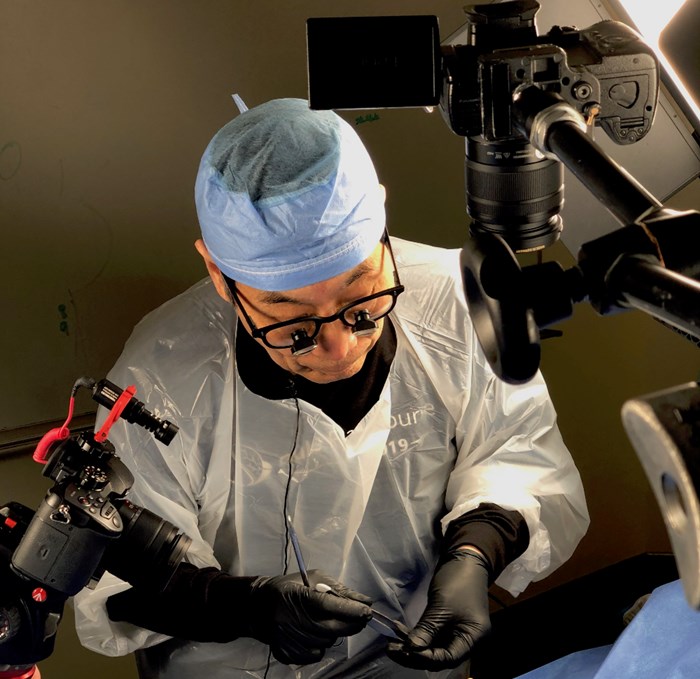Duke Flap Course: Honoring history while adapting to change

Cadaveric dissection courses have emerged in numerous venues as an irreplaceable educational tool in plastic and reconstructive surgery. Firsthand visualization of tissue planes and blood vessels, along with tactile manipulation, allows for an unprecedented learning experience. The Duke Flap Course has been a leader in this approach for nearly two decades.
Originally the vision of L. Scott Levin, MD, Duke University's Plastic, Maxillofacial and Oral Surgery division chief from 1995-2009, the Duke Flap Course was born in the basement of Duke's Bell Building in 2003. In subsequent years, Dr. Levin would secure a large portion of space within the medical school to form a state-of-the-art facility known as the Human Fresh Tissue Lab.
Critical to the success of the flap course was the pioneering work of Clinton Leiweke in cadaver tissue preparation and latex injection. Clint's techniques, along with years of refinements, have allowed thousands of learners to clearly see tiny blood vessels entering into the outer layers of the skin in ways not previously possible. In addition to the Duke Flap Course, the lab has held a variety of courses that include the Craniomaxillofacial Trauma Course, Breast Perforator Course and the Oncological Reconstructive Course.
The strength of evolution
Now entering its 18th year, the Duke Flap Course has evolved. The original format of the course mostly focused on the dissection of muscle flaps; in subsequent years, reconstructive surgery rapidly evolved to shift toward perforator flaps with muscle preservation. With enhanced latex-injection techniques developed in the Duke lab, it became possible to demonstrate these small blood vessels as they traversed the muscle and entered the skin.
Over the next decade, Dr. Levin and Michael Zenn, MD, continued to build the course into an event with an international draw. In 2009, Dr. Levin took a position at the University of Pennsylvania, where he's continued his work with Dr. Zenn and others in anatomic dissection. In the past five years, the Human Fresh Tissue Lab and the Duke Flap Course have undergone a substantial overhaul. Under the leadership of Greg Georgiade, MD (Duke University Plastic Surgery chief, 2011-17) and Jeff Marcus, MD (Duke University Plastic, Maxillofacial and Oral Surgery chief, 2017-present), a significant financial investment has been made to bring the
facility back to the cutting edge in tissue processing, lighting, visual display and recording capabilities.
The Duke Flap Course is currently directed by Detlev Erdmann, MD (an original member of the 2003 flap course), and Scott Hollenbeck, MD. Under their leadership, the course has evolved to incorporate the newest techniques in reconstructive surgery, recently adding lymphatic dissection and nerve repair to the growing list of flap course topics. Participants now have the opportunity to "tailor" their course work. Some find upper- and lower-extremity flaps and techniques more useful to their practice and dedicate more time to these stations, while others prefer to focus on breast and lymphatics. This flexibility in course structure has set the Duke Flap Course apart from other more scripted approaches.
Additionally, as the plastic surgery workforce continues to diversify, Duke Flap Course organizers have felt it important to have faculty that represent our trainees and surgeons. The principles of the course remain simple: Bring people together to learn, while honoring our past and adapting to change, so we're equipped to lead in the future.
New challenges
We have a new and unforeseen challenge for the Duke Flap Course. The COVID-19 pandemic has limited travel and social interaction. This has threatened the existence of many things once considered automatic. Yet, with every challenge comes opportunity. The Duke Flap Course team is working to continue fulfilling the mission of education, networking, team-building and leadership. To achieve these goals, the course directors have prepared a unique, virtual program which will include a combination of didactic lectures from around the world, live cadaver dissections from the Duke Lab and high-definition videos of flap dissection from previous course faculty.
This year's course is being offered free of charge to all members of the plastic surgery community and, at this time, more than 1,000 participants have registered. The ability to reach across the globe to provide educational content has never been more important. Like years past, the Duke Flap Course will continue to innovate and evolve in this new paradigm – and bring people together to learn the art of flap dissection and reconstructive surgery.
Learn more about the Duke Flap Course at http://plastic.surgery.duke.edu/flapcourse, and follow the course on Facebook and Instagram at @dukeflapcourse.
Dr. Atia is PGY3 at Duke University. Dr. Hollenbeck is an associate professor of Surgery and the director of Breast Reconstruction at Duke University, and he also serves as director of the Human Fresh Tissue Lab; co-director of the Duke Flap Course; and co-founder of the Oncological Reconstruction Course.